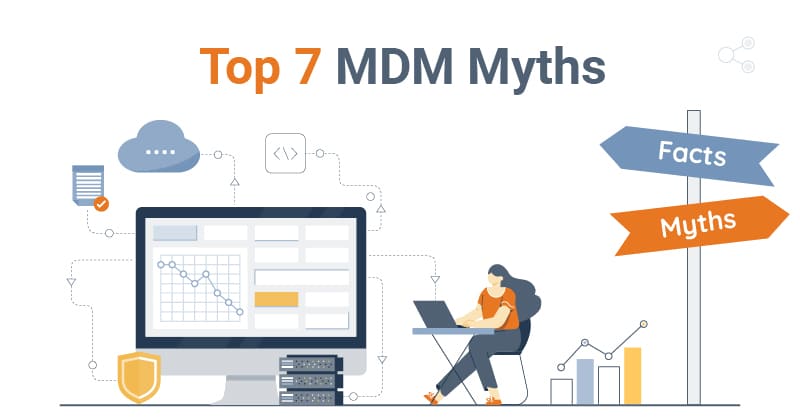Some organizations are hesitant to even consider master data management as they think it’s a practice for large organizations although they could be struggling to control their master data, while others might have suffered a failed MDM implementation due to the lack of a well-planned data governance strategy.
Data can act as a key driver for impactful business outcomes if properly managed and if not, can also become a challenge and lead to operational delays and errors. Well-planned data governance and MDM strategies can help organizations better collect, manage, and distribute that data to maintain consistency and accuracy.
At To-Increase, we have several solutions that have helped customers execute their data governance strategy. Based on our deep-rooted expertise gathered over the years and our experience working with customers across industries, we understand the importance and benefits of having a master data management strategy. We have helped our customers better manage and distribute their master data, improve data quality, and significantly ease data entry processes with our MDM Suite of solutions. And with this blog, we hope to clarify the most common misconceptions about master data management that we have come across.
Related Reading: What is Master Data Management? And How Can it Help Businesses Succeed?
Master data management myths
1) Master Data Management is a solution
Master data management or MDM is the discipline or practice that is supported by a solution.
Gartner defines MDM as a “technology-enabled discipline in which business and IT work together to ensure the uniformity, accuracy, stewardship, semantic consistency and accountability of the enterprise’s official shared master data assets.”
MDM is a part of the organization’s larger data governance strategy that needs to be put together based on outlined processes, responsible people, and defined rules. Therefore, before an MDM solution is implemented, it is important that the right team is assembled, and lay out processes and rules based on best practices. Once these are in place, you can consider a tool to help you realize your goals. Provided that you have a strategy in place, with the responsibilities defined for data owners across the organization, you can improve your chances of success with the implementation of an MDM tool.
2) MDM is just an IT problem
MDM is neither software nor hardware. It is a strategy that needs to be designed with inputs from data owners and users across business units and data domains. The mistake most organizations make is to hand over the responsibility of the MDM strategy to the IT team. The IT Team carries out a framework without any knowledge of business processes and the challenges faced by different teams, and then it might so happen they might not get buy-in from all the business processes and some of them might not adopt the strategy.
Implementing a data governance program, including MDM, requires constant communication and organizational change management. This is crucial for the success of any MDM program. Although the IT team needs to be involved every step of the way to implement and oversee the whole process, the responsibility of data governance cannot be solely handed over to IT. Not only is it important for assigned people from different business units to be involved at the start of the data governance initiative by working on the framework, but this will also ensure smooth adoption of the new MDM and data governance strategy later on.
3) MDM doesn’t need data quality monitoring
At To-Increase, we refer to master data as the ‘one source of truth’ for any organization, it is sacrosanct for organizations. It is data at the final stage when it has been vetted and approved and can be published for the whole organization. But for that to happen, the data needs to be accurate and consistent.
So, if there are no rules or checks for data quality, the master data that is being distributed will not be accurate. The organization will be unable to derive any meaning from its data and make impactful business decisions. In fact, they might experience customer complaints and operational delays among other issues.
Throughout the data lifecycle, data quality rules can help the business achieve validity, consistency, and accuracy. Since data is constantly changing and organizations sometimes have multiple users working on master data, data quality rules can avoid human errors and achieve consistency across the company.
4) MDM is only for enterprises
If you have data flowing through multiple systems that are disconnected and you have no means to manage and control your master data, then whether you are a large or medium or small sized organization, you need to consider some form of data governance for your organization. When multiple business processes share data, the need for an MDM strategy becomes essential.
Additionally, keeping in mind industry regulations to share data with your trading partners, you need to maintain data quality checks to ensure compliance. Most smaller companies consider it a problem only for larger organizations when they suffer from the same challenges that an organization does without an MDM strategy. When your company scales and your data and the number of applications that you use increases, are you going to wait till the situation is out of hand to implement an MDM strategy? We hope not!
5) MDM is expensive
Or many think it is associated with larger enterprises only. Since it is an organizational-wide practice, it is perceived to be a sizeable investment.
It is true that MDM software used to be expensive when the industry wasn’t as mature but now there are solutions for every size, company, and situation. Additionally, most of our customers tell us that they account for MDM software as an operating expense rather than a capital expense. Since we do the heavy lifting by upgrading, hosting, and maintaining the solution, our customers can continue using our cloud-based solution without additional costs post-implementation.
Related Reading: What does our master data management solution – MDM Studio cost?
The best way to go about any MDM project is to have a data governance strategy and an implementation plan in place prior to adopting a new tool. You do not need to hire new resources, instead, you can train your teams to implement the new tools in-house. Therefore, we recommend that you look at user-friendly, no-code solutions.
6) If you have ERP, you don’t need MDM
The reason we built MDM Studio for Microsoft Dynamics 365 Finance & Supply Chain Management ERP was because of feedback from our customers. They told us about their challenges working with D365 and how they had difficulties distributing and managing master data using the ERP.
Microsoft Dynamics 365 Finance & Supply Chain does not have robust MDM capabilities. If you want to use D365 to manage master data, you need to adopt an enterprise-ready solution that can easily integrate with inside D365 Managing data quality and data entry can also be a challenge as it does not allow you to configure a workflow that enables collaboration, approval, and data monitoring.
The challenges listed above can easily be mitigated by an MDM solution such as To-Increase’s MDM suite. Adding data patterns and rules, enabling data entry workflows, collaborating on master data, and adding approval can transform your data into a powerful tool to scale with your business.
7) We migrated to a new ERP, so we don’t need MDM
When you migrate your data, just like when you move houses, you tend to do a clean-up exercise so that you can transfer only the data that is needed to the new ERP. Some of our customers have chosen to implement our master data management solution at the same time as migrating or modernizing their ERP solution.
If you don’t start with a strategy and tool from day 1 then your data will quickly become inconsistent and unreliable again. And spending time and company resources on data clean-up exercises regularly is not as sustainable as implementing an automated solution that allows you to add data quality rules that work in the backend while people across the organization are regularly updating data into different business systems on a daily basis.
Have you changed your mind about master data management?
As highlighted in this blog, if you move past the myths, master data management can provide a host of benefits, including improved data quality and accuracy. Your team will spend less time and effort managing master data, and you will see a visible impact on decision-making. If your organization is facing challenges such as operational errors, frequent customer complaints, and penalties due to data inaccuracies, it might be time to investigate whether the lack of a master data management process is the root cause of all these issues.
If you are keen to learn more about master data management and understand the pitfalls of bad data, download our ebook to know more about the basics of master data and how to create and distribute data within your organization for Microsoft D365 ERP.





